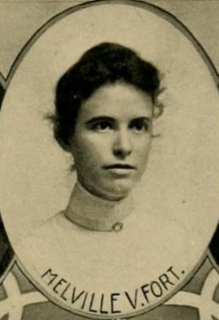Miss Melville Vincent Fort taught art. She may not have been as fashionable as Latin professor Viola Boddie or as majestic as Lady Principal Sue May Kirkland, but she was witty, intelligent, and friendly – a favorite with the faculty and students. Yet while many members of the original faculty have had buildings and conference rooms named in their honor, Miss Fort seems to have eluded the campus recognition gained by others.
Originally from Starkville, Mississippi, Miss Fort graduated with honors from Mississippi Industrial Institute and College, considered the first public women’s college in the United States. She then acquired additional training in New York. Hired as a professor and head of the art department at the State Normal and Industrial School (now UNCG), Miss Fort was paid a significantly lower salary than other teachers at the college. Even though she was qualified for the position, her salary was $450 per year, as compared with Dixie Lee Bryant, who taught Natural Science with a salary of $900. This may reflect the attitude, held by many in education, that art was only a vocational subject, included in the curriculum because it was considered necessary for every future teacher to master. The industrial art department offered classes such as architectural and mechanical drawing, but it also recommended courses in decorative design, art history, china painting, woodcarving, and clay and plaster modeling. Miss Fort was known as an exacting teacher who expected, “respect for order and truthfulness of representation” in her classes. * Art classes met twice a week, and students were required to take a year of training to earn their diploma.
During a time when few teachers could afford their own home and many found themselves living in the dormitories with students, Miss Fort lived with Miss Gertrude Mendenhall, the professor of Mathematics. The teachers lived in “Green Cottage,” a small house directly off campus, entertaining both faculty and students with parties, games, and teas. She was also friends with the wives of the male faculty, especially with Effie Joyner, wife of James Y. Joyner, who taught English at the college from 1893 – 1902.
Miss Fort enjoyed riding her bike through campus and was active in the faculty photography club, but her true love was art. She was a sincere advocate of appreciating art through nature. Miss Fort wrote a moving article about Peabody Park, five miles of graded drives and walkways on the North side of campus, which appeared in The Decennial. It includes the following sentiments:
If the mission of art is to cultivate the power to perceive and to appreciate the beautiful, and, if nature is the source of all art, can there be found a more natural or a more pleasing method of cultivating this power than to lead the student into the beauties of nature?
Her love of art led to interesting travels in her free time. In 1900, Miss Fort took a trip to Europe – all the more amazing given her meager salary. She toured the great art galleries of Europe and came home with many tales of her adventures. The expense of the trip may explain why a few years later, her summer would be spent teaching at the University of North Carolina (now UNC Chapel Hill). Subsequent trips included visiting campus physician Dr. Anna Gove at her family’s New Hampshire home and a pilgrimage in the summer of 1915 to Evangeline Country in Nova Scotia. The Longfellow heroine made quite an impression on Miss Fort and while she was impressed with the history of the poem, she was surprised that the “forest Primeval” and “murmuring pines and hemlocks” were no longer existent in the Canadian countryside described by Longfellow. As a souvenir, Miss Fort took a clipping of a willow tree thought to have been planted by the French Canadians. She wrapped it in a damp cloth and brought it back to the State Normal where Dr. Foust gave her permission to plant it by the entrance of the college.
In 1919, the changing focus of the school and resulting curriculum shifts, resulted in the resignation of Miss Fort and the two other vocational art teachers. Little is known of the details of Miss Fort’s life after leaving the college. She moved to Raleigh where she held part-time positions with the State architect and in the State Revenue Department. Interestingly, she moved in with the Joyner family and lived in their home until Mrs. Joyner died in 1930. Ultimately, Miss Fort was buried in the Joyner family plot in Raleigh after her death in 1939.
* As recalled in 1964 by Mrs. Julius Foust, a student of Miss Fort
Article by Kathelene McCarty Smith

